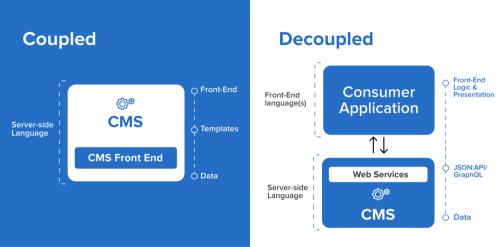Maximizing Marketing Agility with The Power Of Headless Drupal

In the rapidly
evolving digital landscape, marketers face the perpetual challenge of
delivering engaging and personalized experiences across an ever-expanding array
of channels. Traditional content management systems (CMS) often struggle to
keep pace with the demands of modern marketing strategies. However, a solution
has emerged to address these challenges: headless Drupal. This innovative
approach decouples the frontend presentation layer from the backend content
management system, providing marketers with unparalleled flexibility and
efficiency in content delivery and management.
What is Headless
Drupal? Understanding the Basics
Headless Drupal
refers to a content management system architecture where the frontend
presentation layer, responsible for displaying content to users, is decoupled
or separated from the backend content management system. Unlike traditional CMS
platforms, which tightly integrate content creation, storage, and presentation,
headless Drupal allows for greater flexibility by enabling developers to use
any frontend technology or framework to render content, such as JavaScript
frameworks like React or Angular.
Why Headless?
Exploring the Benefits for Marketers
- Seamless Content
Management
Headless Drupal's decoupled architecture offers several advantages for marketers. By separating the frontend from the backend, content creation and publishing workflows are streamlined, allowing marketers to focus on creating engaging content without being constrained by the limitations of a monolithic CMS. Additionally, headless Drupal supports multichannel distribution, enabling content to be delivered seamlessly across various devices and platforms. - Enhanced
Personalization
One of the key benefits of headless Drupal for marketers is enhanced personalization. By leveraging data-driven insights and analytics, marketers can deliver dynamic and personalized content experiences tailored to the preferences and behavior of individual users. Headless Drupal's integration capabilities also allow marketers to connect with third-party tools and platforms, further enhancing the ability to deliver personalized experiences at scale. - Agile Campaign
Execution
Headless Drupal enables marketers to execute campaigns with greater agility and efficiency. Its decoupled architecture facilitates rapid deployment and iteration, allowing marketers to quickly adapt content and messaging based on real-time feedback and performance data. Additionally, headless Drupal supports A/B testing, enabling marketers to fine-tune their strategies for optimal results. Finally, headless Drupal's scalability ensures that marketers can easily scale their campaigns to meet changing business needs and accommodate growth.
Case Studies:
Real-World Success Stories
- Company X:
Revolutionizing Customer Engagement
Company X leveraged headless Drupal to revolutionize customer engagement by delivering immersive experiences across devices. By decoupling the frontend presentation layer from the backend content management system, Company X was able to create dynamic and personalized content experiences that resulted in a 30% increase in conversion rates. - Brand Y: Scaling
Globally with Ease
Brand Y used headless Drupal to scale globally with ease, supporting multilingual and multiregional campaigns. Headless Drupal's decoupled architecture enabled Brand Y to deliver content seamlessly across different languages and regions, reducing time-to-market by 50% and accelerating international expansion.
Best Practices for
Implementing Headless Drupal
- Define Clear
Objectives and Requirements
When implementing headless Drupal, it's essential to define clear objectives and requirements upfront. This involves identifying key business goals and KPIs, as well as collaborating cross-functionally to align stakeholder expectations and ensure that the implementation meets the needs of all stakeholders. - Invest in Robust
Integration Strategies
Robust integration strategies are crucial for successful headless Drupal implementations. This includes evaluating third-party tools and services for seamless connectivity and prioritizing APIs and web services for interoperability. By investing in robust integration strategies, organizations can ensure that their headless Drupal implementation integrates seamlessly with existing systems and processes. - Empower Marketing
Teams with Training and Support
Finally, it's important to empower marketing teams with the training and support they need to succeed with headless Drupal. This involves providing ongoing education on headless Drupal concepts and best practices, as well as fostering a culture of experimentation and continuous learning. By empowering marketing teams with the knowledge and support they need, organizations can maximize the value of their headless Drupal implementation and drive impactful results in today's dynamic digital landscape.
Conclusion
In conclusion,
headless Drupal represents a paradigm shift in content management that empowers
marketers to break free from the constraints of traditional CMS platforms and
unlock new levels of agility and innovation. By leveraging its decoupled
architecture, powerful personalization capabilities, and seamless integration
options, organizations can revolutionize their marketing strategies and drive
impactful results in today's dynamic digital landscape. With clear objectives,
robust integration strategies, and empowered marketing teams, organizations can
harness the full potential of headless Drupal to deliver engaging and
personalized experiences that resonate with audiences across channels.
Post Your Ad Here
Comments